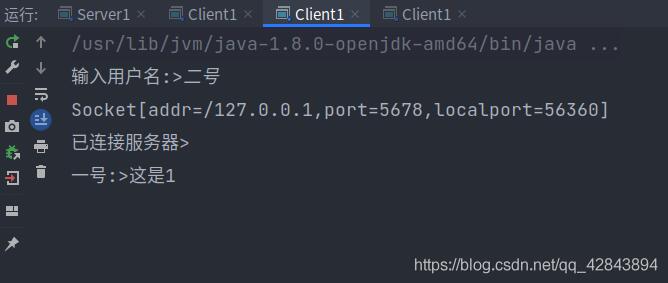Java-Socket编程实现简易聊天室(TCP),供大家参考,具体内容如下
实现一个服务器接收多个客户端
测试:
首先启动服务器,然后启动三个客户端,输入三个不同的用户名,分别在聊天室发消息
看其他客户端是否能接收到消息
效果如下图:
一号发消息

可以在二号和三号客户端接收到消息


服务器设计
import java.io.BufferedReader;
import java.io.IOException;
import java.io.InputStreamReader;
import java.io.PrintWriter;
import java.net.ServerSocket;
import java.net.Socket;
import java.util.ArrayList;
import java.util.List;
import java.util.concurrent.ExecutorService;
import java.util.concurrent.Executors;
public class Server1 {
static public List<Client> list = new ArrayList<Client>();
static ExecutorService cachedThreadPool = Executors.newCachedThreadPool();
public static void main(String[] args) {
//创建一个ServerSocket监听端口
try (ServerSocket server = new ServerSocket(5678)) {
while (true) { // 利用死循环不停的监听端口
Socket s = server.accept();// 利用Socket服务器的accept()方法获取客户端Socket对象。
addClient(s);
}
} catch (IOException e) {
e.printStackTrace();
}
}
// 添加客户端
private static void addClient(Socket s) {
String name;
try {
BufferedReader in = new BufferedReader(new InputStreamReader(s.getInputStream()));
name = in.readLine();
Client c = new Client(name, s);// 创建客户端处理线程对象
System.out.println(name);
list.add(c);
cachedThreadPool.execute(c);
} catch (IOException e) {
e.printStackTrace();
}
}
static class Client implements Runnable {
String name; // 客户端名字
Socket s = null; // 保存客户端Socket对象
BufferedReader in;
PrintWriter out;
Client(String name, Socket s) {
this.s = s;
this.name = name;
try {
in = new BufferedReader(new InputStreamReader(s.getInputStream()));
out = new PrintWriter(s.getOutputStream());
} catch (IOException e) {
// TODO Auto-generated catch block
e.printStackTrace();
}
}
@Override
public void run() {
try {
while (true) {
String str = in.readLine();
for (int j = 0; j < list.size(); j++) {
Server1.Client c = list.get(j);
if (c != this) {
System.out.println(str);
c.send(str+"-|1|2|-"+name);
}
}
if (str.equals("end"))
break;
}
try {
s.close();
} catch (IOException e) {
// TODO Auto-generated catch block
e.printStackTrace();
}
} catch (IOException e1) {
// TODO Auto-generated catch block
e1.printStackTrace();
}
}
public void send(String str) throws IOException {
out.println(str);
out.flush();
}
}
}
客户端设计
import java.io.BufferedReader;
import java.io.IOException;
import java.io.InputStreamReader;
import java.io.PrintWriter;
import java.net.Socket;
import java.util.Scanner;
public class Client1 {
public static String name = null;
static Socket socket = null;
static BufferedReader in;
static PrintWriter out;
public static void main(String[] args) {
Scanner sc = new Scanner(System.in);
System.out.print("输入用户名:>");
name = sc.nextLine();
try {
// socket = new Socket("116.62.173.212", 5678);
socket = new Socket("127.0.0.1", 5678);
System.out.println(socket);
System.out.println("已连接服务器>");
out = new PrintWriter(socket.getOutputStream());
in = new BufferedReader(new InputStreamReader(socket.getInputStream()));
Thread receive = new Thread(new receiveThread());
receive.start();
out.println(name);
out.flush();
String msg;
while (true) {
// System.out.print("你说:>");
msg = sc.nextLine();
out.println(msg);
out.flush();
if (msg.equalsIgnoreCase("end"))
break;
}
} catch (IOException e) {
e.printStackTrace();
}
}
static class receiveThread implements Runnable{
@Override
public void run() {
try {
while (socket!=null) {
String str = in.readLine();
String message = str.split("-\\|1\\|2\\|-")[0];
String name = str.split("-\\|1\\|2\\|-")[1];
System.out.println(name + ":>" + message);
}
}catch(Exception e) {
e.printStackTrace();
}
}
}
}
以上就是本文的全部内容,希望对大家的学习有所帮助,也希望大家多多支持自学编程网。

- 本文固定链接: https://zxbcw.cn/post/207724/
- 转载请注明:必须在正文中标注并保留原文链接
- QQ群: PHP高手阵营官方总群(344148542)
- QQ群: Yii2.0开发(304864863)
